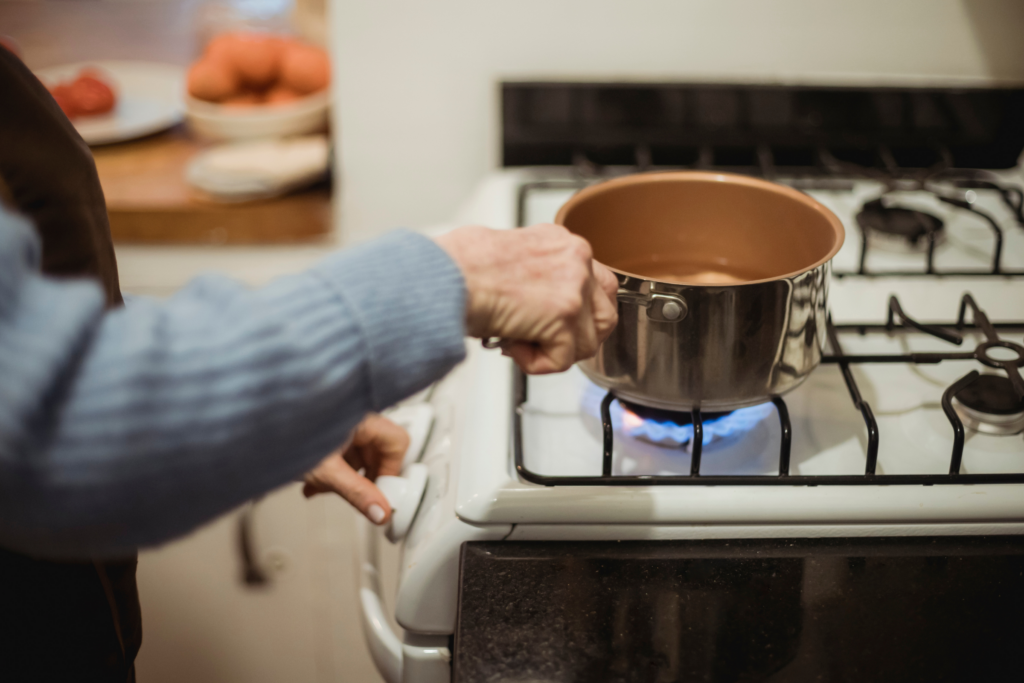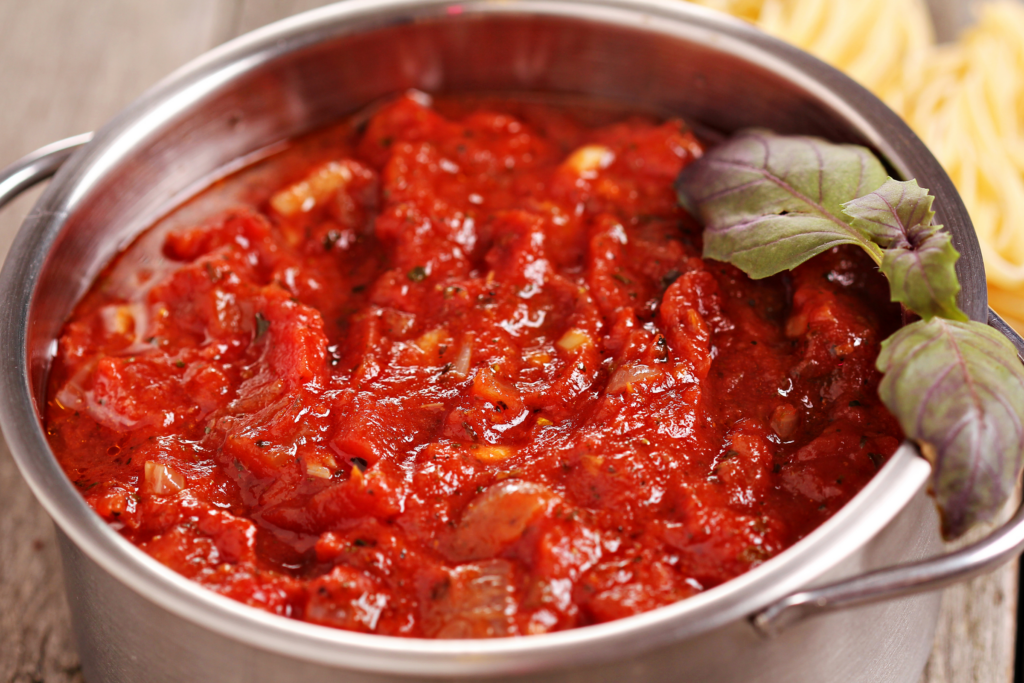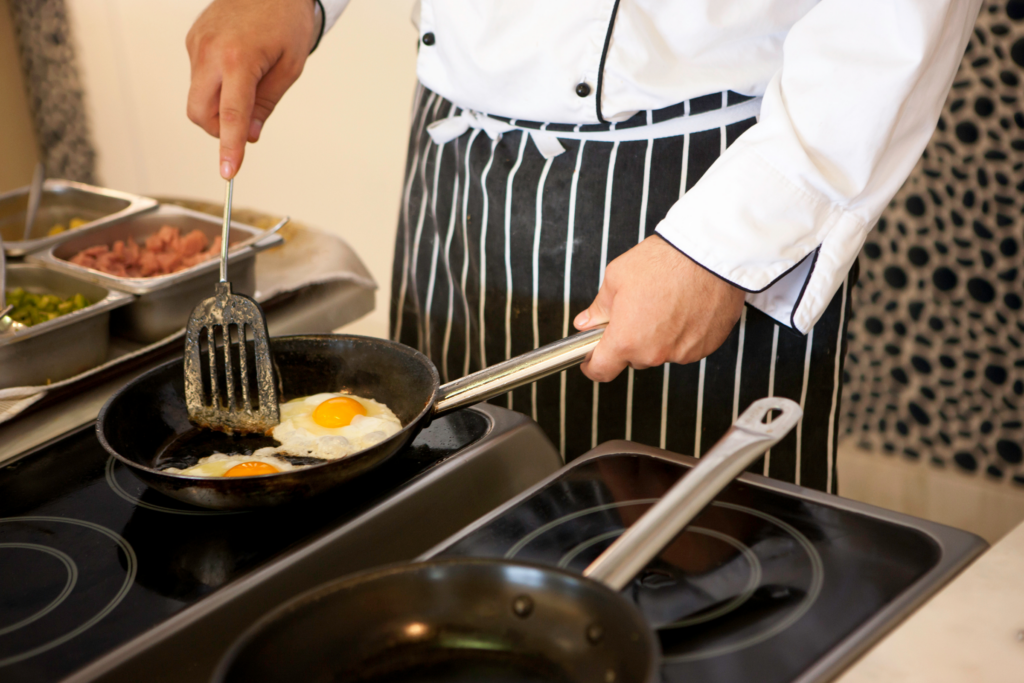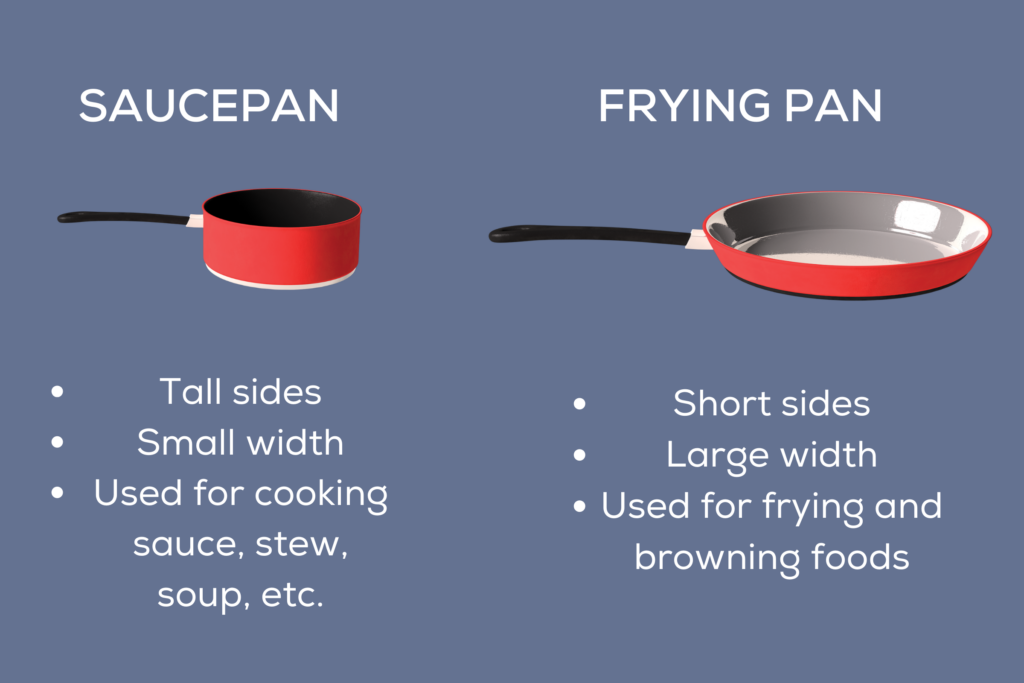Saucepan vs Frying Pan – What’s the Difference?
A saucepan and frying pan are essential for cooking foods like meat, eggs, and vegetables.
While these pans share superficial similarities, is there a significant difference in their purpose and performance?
The difference between a saucepan vs frying pan is that saucepans are created with more depth to hold liquids and cook sauces. On the other hand, frying pans are shallow to help circulate air when frying foods. You can use them interchangeably, though the results will be subpar compared to using each pan as intended.
Given their differences, knowing which pan is best for specific cooking methods is crucial to creating good meals at home.
Read on to learn more about what constitutes a saucepan vs frying pan, their common uses, and whether they can be used interchangeably.
What makes a saucepan unique?
Those new to the kitchen can be easily overwhelmed when inundated with utensils, pots, and pans. If you haven’t cooked before, it may not be intuitive what everything is used for.
That said, let’s break it down: what is a saucepan?
Saucepans are large, deeper cooking pots that make sauces, broths, soups, and stews. Their depth allows them to hold a high volume of liquids, which is why they are great for large liquid batches.
Look at the height-to-width ratio if you need help distinguishing between saucepans and your other pans. A pan with high sides in relation to its width is most likely a saucepan.
These kinds of pans come in several sizes. Some are only large enough to handle a small quantity of ingredients (for sauce), while others can cook up to four quarts of liquid (or more).
The larger ones resemble stockpots in appearance. In general, the higher the edges of a saucepan are, the larger it is and the more liquid it can fit.
Most saucepans will come with a lid; however, they can also be sold without.
They’re also typically equipped with long handles. Some larger units will come with one handle on each side to make the pot simpler to grip. Typically, the second handle is shorter than the first.

7 Uses for a saucepan
As mentioned, saucepans handle large volumes of liquid in one go. This makes them a versatile kitchen tool with many purposes.
Let’s take a quick look at seven potential uses for your saucepan.
- Making sauce – as their name implies, saucepans were initially created to cook sauce. Two great examples would be cooking pasta or barbecue sauce.
- Cook small batches of soups and stews – the depth of saucepans makes them an excellent tool for making soups and stews. These typically involve lots of liquid with meat and vegetables added in.
- Making custard or mashed potatoes – while custard and mashed potatoes are not sauces, they require a lot of room to cook without making a colossal mess. Saucepans are great for this!
- Making risotto – saucepans are great for risotto or thickening up any sauces you may add to your meal.
- Boiling liquids – a saucepan can quickly bring liquids to a high temperature. This makes them ideal for quickly heating water for foods like pasta, rice, or quinoa instead of using a bulky stockpot.
- Blanching vegetables – some cuisines, like specific Asian cuisines, use blanched vegetables in many dishes. This includes boiling them quickly and then transferring them to an ice bath. Saucepans are great for boiling the water for the initial step.
- Poaching – this moist-heat cooking method involves submerging food in liquid without using fat, similar to simmering and boiling. Poached eggs are an example of how you could use a saucepan for this cooking technique.

Advantages of cooking with a sauce pan
Aside from the apparent benefits of cooking sauce with a saucepan, there are other advantages that you should consider before purchasing one or using one to cook.
Here are some of the best advantages of cooking with a saucepan:
- Versatility – saucepans have many uses, including cooking sauce, steaming, and boiling. As a result, by purchasing only one piece of cookware, you can save money.
- Compact size – the saucepan’s compact size saves users space. Couple this with its versatility, and you’ll find you can get by with minimal kitchen materials.
- Compatible with different cooktops – the pans are compatible with various cooktops, allowing you to select a saucepan based on the cooktop you have at home (including gas stoves, electric, and induction).
- Variety of materials available – saucepans are available in different materials like stainless steel, copper, aluminum, cast-iron, and ceramic. Whatever your cooking preference is, you can most likely find it.
- Lids come in handy – saucepans have tight-fitting lids, which expedite boiling liquids and steaming your food. In addition to their lid, they also have handles so you can cook safely without excessive risk of burning yourself.
- Available in non-stick – non-stick saucepans are available, which makes cleaning them after each use quick and easy. Some are even dishwasher-safe!
What makes a frying pan unique?
So, we know we can make sauces, boil liquids, and cook large quantities of food like mashed potatoes and risotto in saucepans.
What about when we want to fry up an egg or get a nice sear on a ribeye?
Enter the frying pan.
On the other hand, frying pans are shallower and have slightly angled sides. They’re typically smaller than saucepans, and their low sides give them an even more diminutive appearance. They may, however, have a much larger circumference, exposing more surface area to the heat.
While some frying pans come with matching lids, it’s rare. Because of their slanted sides, it’s impossible to form a tight seal, although you can always try using a lid that fits a different pot or pan.
That’s alright, though. Their cooking usages don’t require a lid.
Another significant difference when examining a saucepan vs frying pan is the short sides. This helps the smoke that arises from frying food escape the pan. If contained in the pan, it would steam the food, and you wouldn’t get the crispy finish you’re after.
Lastly, frying pans typically only have one handle, whereas saucepans have two.

6 uses for a frying pan
As with saucepans, frying pans are a versatile tool that should be a staple in your daily kitchen usage.
What exactly can a frying pan be used for?
- Frying – as you probably could have guessed, frying pans are mainly used to fry food. Pan-frying is a dry heat cooking technique that uses oil or fat as a heat transmission medium. The oil produces steam, which aids in cooking the meat, and the exposed topside allows any moisture to escape—direct contact with the pan’s bottom results in more browning and crisping.
- Stir-frying – similar to the aforementioned pan-frying method, stir-frying is when you fry food over high heat while constantly stirring. Once again, they got creative with the name here!
- Browning – often, we want to brown our meat before transferring it to a pot or the oven to finish cooking. Fry pans are perfect for this because you’re just briefly frying your food.
- Toasting – if you don’t have a toaster, frying pans are great for toasting any bread. Adding olive oil or butter and then toasting your bread can be done quickly in a frying pan.
- Searing – fry pans are great for searing as searing is a method of air-frying where rather than moving the food around, you let it sit in the hot pan to develop a sear, or crust, on the outside of the food. This is commonly applied to cooking meat like steak or chicken breast.
- Deep-frying – lastly, deep-frying can also be done in frying pans. However, you will need a pan with relatively decent depth because this involves dropping your food into a pool of hot oil to cook.
Advantages of cooking with a frying pan
Frying pans are a great tool to have with many advantages. I would say that my frying pan is the most used equipment in my kitchen, between making eggs for breakfast and cooking meat for dinner.
Here are some of my favorite advantages to having a frying pan on hand:
- Even food distribution – since frying pans are large and shallow, the food is distributed evenly and thinly. The heat will also be evenly distributed across the pan’s bottom. This ensures evenly cooked food.
- Quick cooking – Food cooked in a frying pan cooks faster than food cooked in other pots and pans. This is a result of better heat distribution as well as contact with the pan itself.
- Intense flavors – an added benefit of quick cooking is intense flavors. Quick cooking ensures your food doesn’t dry out and have the flavors cooked out of it.
- Preserves nutrients – the longer an item is cooked, the less flavor and nutrients it retains. Thus, pan-fried foods are more nutrient-dense than their oven-cooked counterparts.
- Excellent texture – pan-frying browns foods and makes them nice and crispy. Food that is cooked for extended lengths of time becomes crispier and tastes fresher. Using a saucepan to crisp foods isn’t ideal because the tall sides keep moisture inside, making food soggy.
- Available in non-stick – many non-stick frying pans allow users to cook food without oil. This means frying pans can also be used to cook healthy recipes without added calories from fats.
Saucepan vs frying pan – Can a saucepan be used as a frying pan?
Examining a saucepan vs frying pan reveals the truth: can a saucepan be used as a frying pan?
A saucepan can be used as a frying pan, but we don’t recommend using a saucepan to fry your food. You will have much better results using a frying pan to cook and crisp up your food.
Granted, you could swap them out in a tight situation; saucepans are the polar opposite of what you’re looking for in a good frying.
A good frying pan has low sides and excellent air circulation; most saucepans have tall sides to trap moisture. See the issue?
Frying your food in a saucepan will likely result in soggy, moist food rather than food with a nice browning and crisp exterior.

Can a frying pan be used as a saucepan?
Let’s look at the flipside. Can you use a frying pan as a saucepan?
Unfortunately, frying pans are not suitable alternatives to saucepans. Attempting to make sauce or boil vegetables in a frying pan will likely leave you frustrated and with a messy kitchen.
Saucepans have tall sides to trap moisture and keep the sauce in the pan rather than all over the kitchen counter.
Just as we don’t recommend using a sauce pan to fry foods, you shouldn’t use a frying pan to make sauces.
You could make it work, but it’s less than ideal. Don’t say we didn’t warn you!
Is a saucepan the same as a frying pan?
No, they are not the same. Saucepans have tall sides and smaller widths, whereas frying pans have short sides with larger widths.
What is the difference between a saucepan and sauté pan?
A sauté pan is the intermediate pan between a saucepan and a frying pan. It is wider than a saucepan, but it still has taller sides than a frying pan.
Can I cook a sauce in frying pan?
You could, but we don’t recommend doing so as it will most likely leave a mess.
Let Us Know How We’re Doing!
Did this expertly prepared resource answer your question?
Do you have another question about home maintenance, home improvement projects, home appliance repair, or something else?
Get more information, send in questions and keep the discussion going by contacting the I’ll Just Fix It Myself company customer service team at at 1-800-928-1490 or Email us at [email protected]
